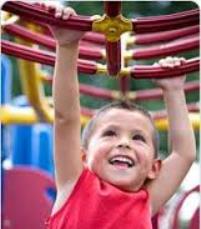It is important that the play equipment on your playground is age appropriate. When it comes to playground equipment and playground design, the age categories of children are given serious consideration; playgrounds are designed in scale with its users’ ranges of physical abilities, sizes, and developmental levels. ASTM safety guidelines recognize three distinct age categories for various types of playground equipment: toddlers (ages 6-23 months), preschool (ages 2-5 years) and grade school (ages 5-12 years). Play equipment for different age ranges should be installed in separate areas of the playground.
For example, toddler equipment includes swings with bucket seats, spring riders no higher than 16′, slide exits no higher than 6″ above the safety surfacing, ramps or straight stairways for easy access, decks and platforms no higher than 2’8″ from the safety surfacing with guardrails and barriers on all elevated walking surfaces 1’6″ above the ground. Unitary safety surfacing like synthetic turf or poured-in-place rubber prevents toddlers from eating loose surfacing like wood fiber, rubber mulch and pea gravel.
If we compare the guidelines for toddlers with those recommended for school-age users, it is easy to see that a toddler wouldn’t be safe or enjoy playing on equipment intended for 5-12 year olds. The average height of a toddler is 36″; they are top heavy and fall easily, and, and they lack the strength to pull themselves up or to hang from their arms for longer than half a minute.
When choosing your playground equipment, it is important to consider the ages of its intended users.To minimize injuries, separate your play areas by age groups and remember–each individual play area should comply with the ASTM guidelines for its particular age group.

